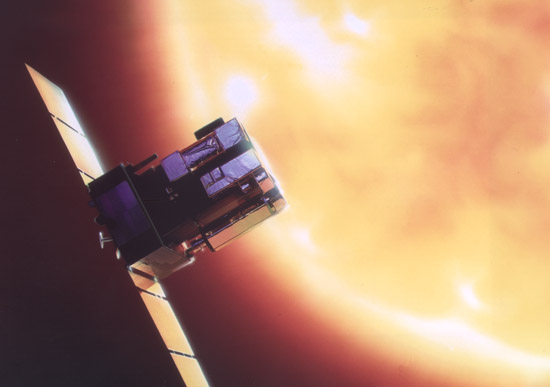|

by Rebecca Sato
November 21, 2008
from
DailyGalaxy Website

Dark spots, some as large as
50,000 miles in diameter, typically move across the surface of the
sun, contracting and expanding as they go.
These strange and powerful phenomena are
known as sunspots, but now they are all gone. Not even solar
physicists know why it’s happening and what this odd solar silence
might be indicating for our future. The last time this happened was
400 years ago - and it signaled a solar event known as a "Maunder
Minimum," along with the start of what we now call the "Little Ice
Age."
Although periods of inactivity are normal for the sun, this current
period has gone on much longer than usual and scientists are
starting to worry - at least a little bit. Recently 100 scientists
from Europe, Asia, Latin America, Africa and North America gathered
to discuss the issue at an international solar conference at Montana
State University.
Today's sun is as inactive as it was two
years ago, and solar physicists don’t have a clue as to why.
"It continues to be dead," said
Saku
Tsuneta with the National Astronomical Observatory of Japan,
program manager for the Hinode solar mission, noting that it is
at least a little bit worrisome for scientists.
Dana Longcope, a solar physicist
at MSU, said the sun usually operates on an 11-year cycle with
maximum activity occurring in the middle of the cycle. The last
cycle reached its peak in 2001 and is believed to be just ending
now, Longcope said. The next cycle is just beginning and is expected
to reach its peak sometime around 2012.
But so far nothing is happening.
"It's a dead face," Tsuneta said of
the sun's appearance.
Tsuneta said solar physicists aren't
weather forecasters and they can't predict the future. They do have
the ability to observe, however, and they have observed a
longer-than-normal period of solar inactivity. In the past, they
observed that the sun once went 50 years without producing sunspots.
That period coincided with a little ice age on Earth that lasted
from 1650 to 1700.
Coincidence? Some scientists say it was,
but many worry that it wasn’t.
Geophysicist Phil Chapman, the first Australian to become an
astronaut with NASA, said pictures from the US Solar and Heliospheric Observatory also show that there are currently no spots
on the sun.
He also noted that
the world cooled
quickly between January last year and January this year, by about
0.7C.
"This is the fastest temperature
change in the instrumental record, and it puts us back to where
we were in 1930," Dr Chapman noted in The Australian recently.
If the world does face another mini Ice
Age, it could come without warning. Evidence for abrupt climate
change is readily found in ice cores taken from Greenland and
Antarctica. One of the best known examples of such an event is the
Younger Dryas cooling, which occurred about 12,000 years ago, named
after the arctic wildflower found in northern European sediments.
This event began and ended rather abruptly, and for its entire 1000
year duration the North Atlantic region was about 5°C colder. Could something like this happen again?
There’s no way to tell, and because the changes can happen all
within one decade - we might not even see it coming.
The
Younger Dryas occurred at a time when orbital forcing should
have continued to drive climate to the present warm state. The
unexplained phenomenon has been the topic of much intense scientific
debate, as well as other millennial scale events.
Now this 11-year low in Sunspot activity has raised fears among a
small but growing number of scientists that rather than getting
warmer, the Earth could possibly be about to return to another
cooling period. The idea is especially intriguing considering that
most of the world is in preparation for global warming.
Canadian scientist Kenneth Tapping of the National Research Council
has also noted that solar activity has entered into an unusually
inactive phase, but what that means - if anything - is still anyone’s
guess. Another solar scientist, Oleg Sorokhtin, a fellow of
the Russian Academy of Natural Sciences, however, is certain that
it’s an indication of a coming cooling period.
Sorokhtin believes that a lack of sunspots does indicate a coming
cooling period based on certain past trends and early records. In
fact, he calls manmade climate change "a drop in the bucket"
compared to the fierce and abrupt cold that can potentially be
brought on by inactive solar phases.
Sorokhtin’s advice:
"Stock up on fur coats"…just in
case.
The “Little Ice Age” Argument Makes a
Comeback
Abrupt Climate Change Goes Both Ways, Warns
Scientist
April 24, 2008

Evidence has mounted that global warming
began in the last century and that humans are, at least in part,
responsible.
The concern is that the warming of our climate will
greatly affect its habitability for many species, including humans.
Both the Intergovernmental Panel on Climate Change (IPCC) and the
U.S. National Academy of Sciences concur that this is the case.
But some argue that this thinking is too
limited. They say that too many scientists are either ignoring, or
don’t understand, the well-established fact that Earth’s climate has
changed rapidly in the past and could change rapidly in the
future - in either direction.
Evidence for abrupt climate change is readily found in ice cores
taken from Greenland and Antarctica. One of the best known examples
of such an event is the Younger Dryas cooling of about 12,000 years
ago, named after the arctic wildflower found in northern European
sediments. This event began and ended rather abruptly, and for its
entire 1000 year duration the North Atlantic region was about 5°C
colder.
Could something like this happen again?
It sure could, and because the changes can happen all within one
decade - we might not even see it coming.
The Younger Dryas occurred at a time when orbital forcing should
have continued to drive climate to the present warm state. The
unexplained phenomenon has been the topic of much intense scientific
debate, as well as other millennial scale events.
Now an 11-year low in Sunspot activity has raised fears among a
small number of scientists that rather than getting warmer, the
Earth could possibly be about to return to another cooling period.
The idea is especially intriguing considering that most of the world
is in preparation for global warming.
Could we be preparing for the wrong
scenario?
A sunspot is a region on the Sun that is cooler than the rest and
therefore appears darker. One theory is that a strong solar magnetic
field, which causes plenty of sunspot activity, protects the earth
from cosmic rays, but that when the field is weak - during low
sunspot activity - the rays can penetrate into the lower atmosphere
and cloud cover increases, which in turn leads to a cooler surface.
Geophysicist Phil Chapman, the first Australian to become an
astronaut with NASA, notes that pictures from the US Solar and
Heliospheric Observatory show that there are currently no spots on
the sun.
He believes this is the reason why the world cooled rapidly
between January last year and January this year, by about 0.7C.
"This is the fastest temperature
change in the instrumental record, and it puts us back to where
we were in 1930," Dr Chapman writes in The Australian today. "If
the temperature does not soon recover, we will have to conclude
that global warming is over."
However, scientists from the US National
Center for Atmospheric Research published a report in 2006 that
claims the Sun likely has a negligible effect on climate change.
Another study, recently published study in the
Institute of Physics'
Environmental Research Letters, by researchers from Lancaster and
Durham Universities found that there was no strong correlation
between cosmic rays and the production of low cloud cover.
If that is correct, it would mean the
lack of sunspots is not necessarily an indicator of higher cloud
cover and subsequent future cooling.
While it’s true that some world regions have experienced record
colds recently, other areas do seem to be warming up. In Australia,
The Bureau of Meteorology says that temperatures there have been
warmer than the 1960-90 average since the late 1970s. Even though
there have been some cooler years mixed in, overall they are now
0.3C higher than the long-term average. Other countries are
experiencing similar upward trends.
On the other hand, since widespread
temperature records have only been kept for a relatively short
period of the Earth’s history, it’s hard to know exactly what these
increases mean from a long-term perspective.
Cooling, or “Little Ice Age” proponents like Chapman, say that it
could still swing either way.
He proposes preventive measures to slow
any potential cooling, such as bulldozing Siberian and Canadian snow
to make it dirty and less reflective.
"My guess is that the odds are now
at least 50:50 that we will see significant cooling rather than
warming in coming decades."
Canadian scientist Kenneth Tapping of
the National Research Council has also noted that solar activity has
entered into an unusually inactive phase, but what they means - if
anything - is still anyone’s guess.
Another scientist, Oleg Sorokhtin,
a fellow of the Russian Academy of Natural Sciences agrees with
Chapman. Sorokhtin believes that, in spite of the results of certain
recent studies, lack of sunspots does indicate a coming cooling
period. In fact, he calls manmade climate change "a drop in the
bucket" compared to the cold brought on by inactive solar phases.
But while Sorokhtin is advising people to "stock up on fur coats",
the vast majority of prominent scientists believe the bulk of
evidence points towards an overall warming trend, and that anomalies
and exceptions to the rule do not make a significant dent in this
consensus.
The Daily Galaxy asked climate expert Thomas Reichler, what
he has to say about it.
According to him, anyone claiming that the
Earth isn’t getting warmer, or that it’s perhaps even getting
colder, simply isn’t looking at the actual data.
“There is absolutely no doubt that
the world is in a warming phase,” Reichler told the Daily
Galaxy, “and that conclusion is supported by 99% of all serious
scientists, so I’m certainly not alone in that certainty.”
Reichler is probably right, but it
wouldn’t be the first time if the fringe opinion turned out to be
onto something.
But from a broader perspective, does it really
matter who’s “right” as far as preparations go? Whether the climate
gets cooler or warmer, or does nothing at all, people will still
need massive amounts of energy.
Even if we were to take the reverse
approach and intentionally increase greenhouse gases in the
atmosphere in order to stave off cooling, it would likely have
little effect other than to further pollute the environment with
standard energy consumption’s many toxic byproducts.
Are humans the major factor in the current warming trend? Maybe,
maybe not.
But what can’t be disputed is that humans are
polluting
the planet. Current and future weather conditions do not change the
fact that using oil and coal for energy isn’t a good long-term idea.
The need for cleaner energy, cleaner air and cleaner water has never
been greater.
The widespread call for better handling
of resources, and habitat protection doesn’t change with the
thermometer.
Our commitment to stop polluting our water systems with pesticides
and other dangerous chemicals should be as great as ever, with or
without climate change considerations. Dismal air quality now poses
significant health risks, especially in urban areas. Those who
equate their global warming skepticism with an “anything goes”
attitude regarding the environment are seriously jeopardizing the
health of our planet and their own health along with it.
If we prepare for global warming in ways
that help protect the environment - we’ll still be a lot better
off - even on the off chance that we end up with a mini Ice Age
instead.
The Milky Way Enigma
How Galactic Forces May Control Life on Earth
July 19, 2007

Horoscope enthusiasts will be happy to hear that a grand cosmic
force does indeed seem to be responsible for controlling the
direction of all life on Earth.
However, this grand cosmic cycle has
more to do with extinction than finding a tall, handsome stranger.
Earlier this year, research revealed that the rise and fall of
species on Earth seems to be driven by the undulating motions of our
solar system as it travels through the Milky Way. Some scientists
believe that this cosmic force may offer the answer to some of the
biggest questions in our Earth’s biological history - especially where
evolution has fallen short.
Researchers at the University of California, Berkeley found that
marine fossil records show that biodiversity increases and decreases
based on a 62-million-year cycle. At least two of the Earth's great
mass extinctions-the Permian extinction 250 million years ago and
the Ordovician extinction about 450 million years ago-correspond
with peaks of this cycle, which can't be explained by evolutionary
theory.
Earlier this year, a team of researchers at the University of Kansas
came up with an out-of-this-world explanation for the phenomenon.
Their idea hinges upon the fact that stars move through space and
sometimes rush headlong through galaxies, or approach closely enough
to cause a brief cosmic tryst.
Our own star moves toward and away from the Milky Way's center, and
also up and down through the galactic plane. One complete
up-and-down cycle takes 64 million years- suspiciously close to the
Earth's biodiversity cycle.
Once the researchers independently confirmed the biodiversity cycle,
they then proposed a novel mechanism whereby which the Sun's
galactic travels is causing it.
It’s no secret that the Milky Way is being gravitationally pulled
toward a massive
cluster of galaxies, called the
Virgo Cluster,
which is located about 50 million light years away.
Adrian Melott
and his colleague Mikhail Medvedev, speculate that as the
Milky Way rushes towards the Virgo Cluster, it generates a so-called
bow shock in front of it that is similar to the shock wave created
by a supersonic jet.
"Our solar system has a shock wave
around it, and it produces a good quantity of the cosmic rays
that hit the Earth. Why shouldn't the galaxy have a shock wave,
too?" Melott asks.
The galactic bow shock is only present
on the north side of the Milky Way's galactic plane, because that is
the side facing the Virgo Cluster as it moves through space, and it
would cause superheated gas and cosmic rays to stream behind it, the
researchers say.
Normally, our galaxy's magnetic field shields our
solar system from this "galactic wind."
But every 64 million years, the solar
system's cyclical travels take it above the galactic plane.
"When we emerge out of the disk, we
have less protection, so we become exposed to many more cosmic
rays," Melott has said.
The boost in cosmic-ray exposure may
have a direct effect on Earth's organisms, according to
paleontologist Bruce Lieberman.
The radiation would lead to higher
rates of genetic mutations in organisms or interfere with their
ability to repair DNA damage. In this way, the process could lead to
new species while killing off others.
Cosmic rays are also associated with increased cloud cover, which
could cool the planet by blocking out more of the Sun's rays. They
also interact with molecules in the atmosphere to create nitrogen
oxide, a gas that eats away at our planet's ozone layer, which
protects us from the Sun's harmful ultraviolet rays.
Richard Muller, one of the UC Berkeley physicists who co-discovered
the cycle, said Melott and his colleagues have come up with a
plausible galactic explanation for the biodiversity cycle.
If future studies confirm the galaxy-biodiversity link, it would
force scientists to broaden their ideas about what can influence
life on Earth.
"Maybe it's not just the climate and
the tectonic events on Earth," Lieberman said. "Maybe we have to
start thinking more about the extraterrestrial environment as
well."
|



